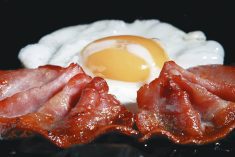Steamed meat-filled buns
Recently I was given this tasty recipe and asked to make it for an ethnic potluck at our church. I found it interesting because my mother-in-law often made meat or cabbage filled buns that were baked. This dough and meat fillings are similar but the buns are steamed. They look much like a dumpling but taste like a bread bun.
I also baked a few to compare them to our family recipe and they were also delicious. I now prefer this meat filling because of the added vegetables and seasonings. I have added our cabbage filling at the end for those who would like to try it.
Read Also

Trump’s trade policies take their toll on Canadian producers
U.S. trade policy as dictated by president Donald Trump is hurting Canadian farmers in a multitude of ways.
Steamed buns
The following quantities make 10 buns, enough for one of the filling recipes. Double or triple the ingredients if you are making more than one filling or for a larger number.
31Ú4 cups flour 800 mL
1 tablespoon 15 mL
yeast
1 teaspoon sugar 5 mL
1Ú2 cup warm water 125 mL
3Ú4 cup milk 175 mL
2 teaspoons sugar 10 mL
1 tablespoon oil 15 mL
1Ú2 teaspoon salt 2 mL
(This recipe uses conventional yeast. Quick rise yeast can be substituted following the directions on the yeast container.)
Sift flour, dissolve sugar in warm water, add yeast.
Scald milk. Stir together warm milk, sugar, oil and salt.
Add yeast mixture. Add flour gradually to make a moderate soft dough. Knead until smooth and elastic (five to eight minutes).
Put into a greased bowl. Turn upside down. Cover and let rise until double (45-60 minutes).
Punch down, turn onto a lightly floured surface. Divide into 10 balls, cover and let rise five minutes. Roll each ball into a 31Ú2 inch (nine centimetre) circle. Place a rounded tablespoon of filling in the centre. Bring edges of dough up around filling, stretching a little until the edges just meet. Pinch to seal.
Place buns seam side down on a piece of lightly greased wax paper. When enough are made to fill your steamer, place the buns seam side down on steamer rack. Don’t let the buns touch. Steam 15-17 minutes.
Do not let the buns rise prior to steaming. Refrigerate what you don’t have room for in the steamer until they can be cooked.
Fillings: Cook meat fillings ahead, drain and cool.
Beef filling
1Ú2 pound ground 250 g
beef
1Ú2 cup chopped 125 mL
mushrooms
1Ú4 cup chopped 50 mL
scallions (green onions, shallots or leeks)
1Ú3 cup chopped 75 mL
celery
salt and pepper to taste
1 tablespoon soy 15 mL
sauce
2 teaspoons 10 mL
brown sugar (optional)
1 clove minced 1
garlic or
1Ú2 teaspoon garlic 2 mL
powder
Pork filling
1Ú2 pound ground 250 g
pork
1Ú2 teaspoon 2 mL
powdered ginger
1 clove minced 1
garlic or
1Ú2 teaspoon garlic 2 mL
powder
1Ú4 cup chopped 50 mL
scallions (green
onions, shallots or leeks)
1Ú3 cup chopped 75 mL
celery
salt and pepper to taste
- Sweet buns
Add 1 teaspoon (5 mL) brown sugar to each bun.
Sweet filling
1 pound 500 g
chopped dates
1Ú4 cup sesame 50 mL
seeds
1 teaspoon ground 5 mL
ginger
1Ú4 cup crushed 50 mL
almonds
2 tablespoons 25 mL
honey
2 teaspoons 5 mL
grated orange
Cabbage filling
2 cups thinly 500 mL
sliced cabbage
1Ú2 cup chopped 125 mL
onion
salt and pepper to taste
2 tablespoons 25 mL
margarine
Stir fry cabbage and onion in margarine until limp. Add salt and pepper to taste. Cool and use as filling for buns.
Grape wine
Dear TEAM: I have made lots of grape jelly from our grapes, but I would like to try some grape wine next year. Do you know of an easy way to make some good wine? – Grape fan.
Dear grape fan: I haven’t made any wine myself but I came across this simple recipe in the Original Hutterite Style Cooking cookbook. It looks quite simple and easy to do.
Wild grape wine
1 gallon wild 4 L
grapes
3 gallons water 12 L
15 pounds sugar 7.5 kg
Ferment for one week. Take off juices and sieve it three or four times. Let it age.
The following recipe is one that Emmie Oddie had received from a reader and printed in The Western Producer in 1968. The sender said it was a good recipe.
Grape wine
2 quarts Welch’s 2 L
grape juice
2 quarts water 2 L
4 cups sugar 1 L
1Ú4 teaspoon dry 1 mL
yeast
1Ú2 cup raisins 125 mL
(The yeast is a specialized one for wine making and can be purchased from a wine producer’s supply store.)
Mix ingredients together and put in a large crock. Let stand for 21 days. Drain into clean jugs and let stand seven more days and it is ready to use.
Some general information I found about wine making in an old Agriculture Canada booklet states that it is important to use only glass, plastic or earthenware utensils for fermenting the pulp or juice. Contact with iron or copper causes the wine to darken and zinc-coated (galvanized) containers may produce unpleasant flavors. Stoneware crocks are the most convenient for fermenting pulped fruit and glass or plastic carboys (large bottles with a long neck) are the best for fermenting juice.
Clean all utensils thoroughly and rinse them with boiling water before use. If stoneware crocks are used, cover them with cheesecloth to keep fruit flies out and to let the carbon dioxide escape.
In speaking to a friend who makes wine, she recommended going to a wine making supply store for equipment, supplies and information. They are generally very helpful and knowledgeable.
Low fat, sugar-free baking
When using nuts in your baking:
- Use half as many nuts and toast them to intensify their flavor. Spread them in a shallow pan and bake in 325 F (160 C) oven for five to seven minutes, or until fragrant. Let cool.
- Use half as many nuts and try supplementing them with crunchy Grape Nuts cereal.
Ironing trivia
Did you know that:
- 40 percent of Canadians iron garments as they need them.
- 60 percent of Canadians spend 11Ú2 hours per week batch ironing (ironing all the clean clothes in the laundry basket at once.)
- 15 percent are male ironers.
- The most frequently ironed items are a women’s blouse (92 percent), followed by a man’s/woman’s shirt (91 percent).
- The average time spent ironing per garment is 6.6 minutes.
- There are 1.2 million irons sold per year. That’s one every two minutes.
Statistics are from Garment Care Xpress, a guide to streamlining and simplifying garment care from Black and Decker and The Good Housekeeping Institute.














